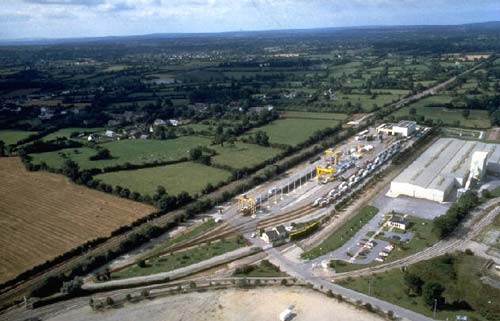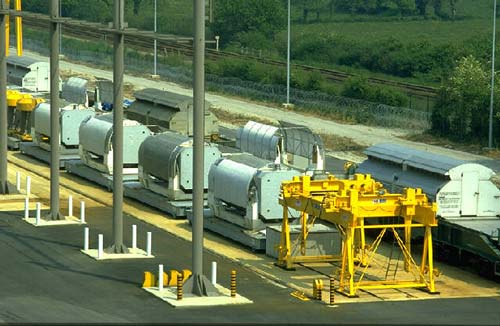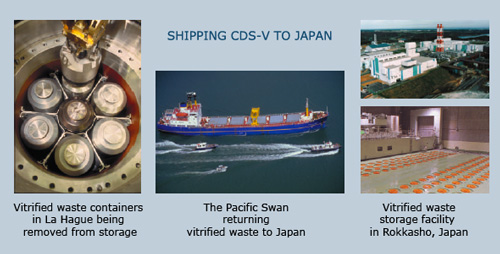High level waste transportation
Moving highly radioactive materials

Valognes rail terminal
Aerial view of the Valognes rail terminal. This terminal, located approximately 20 km from Cherbourg, specialises in handling inbound and outbound consignments of nuclear materials for the reprocessing plant in La Hague.
© SIDNEY JEZEQUEL /AREVA
The 10% of transport movements that concern high-level radioactive materials produced by nuclear reactors require the highest level of supervision and radiation protection. There are 450 irradiated fuel movements each year in France, as well as around 50 plutonium oxide movements and around 10 MOX fuel movements.
fuel movements.
The reprocessing of irradiated fuel, as practiced in France, requires radioactive materials to be transported from the nuclear power plant to the reprocessing plant. In the United States, where spent fuel remains in interim storage near power plants pending disposal, spent fuel transport movements are currently still rare but will be necessary in the future.

Reception of irradiated fuel
After travelling by rail to the terminal in Valognes, these transport casks containing irradiated fuel assemblies have been unloaded from the wagons and await the final leg of their journey: a 20 km transfer by road to the La Hague plant, where the fuel assemblies will be reprocessed.
© SIDNEY JEZEQUEL /AREVA
When removed from the reactor unit’s spent fuel pit where they were stored, fuel elements are highly radioactive, emitting around two million curies (74,000 TBq) per tonne after one year in storage. Fuel elements must be transported in specially-designed containers known as « casks » due to this high level of radioactivity. In France, PWR fuel assemblies are transported in casks containing twelve 500 kg fuel assemblies, in a dry air atmosphere.
Transport casks act as a containment barrier, enabling fuel elements to be transported by road or rail. These steel containers are very strong. They have thick walls that protect against radiation and are sealed to prevent any dissemination of radioactive materials.
Almost all irradiated fuel designated for reprocessing is carried by rail to the Valognes rail terminal and then transferred by road to the plant in La Hague. Sea transport is mainly used by Japan and remote countries such as Australia that do not have their own reprocessing facilities. Japan sends its irradiated fuel to reprocessing plants in La Hague and in Sellafield in the United Kingdom.
Upon arrival, the cask containing the irradiated fuel elements is unloaded. The fuel elements are removed and placed into one of the large pools at the reprocessing plant in La Hague, where they will spend several more years before being reprocessed.
After reprocessing, the recovered plutonium is conditioned in boxes and sent to the MOX fuel manufacturing plant. As plutonium is a fissile material, it is held in small quantities in multiple boxes, to ensure that it cannot reach critical mass.

Returning vitrified waste to Japan
Japan currently sends its spent fuel for reprocessing in France. The resulting vitrified waste is loaded into specially-designed containers that are shipped back to Japan and stored pending construction of a waste repository.
© DR
Transport of vitrified waste: French vitrified waste is currently held in interim storage at the plant in La Hague. It does not yet require transport.
Waste belonging to other countries is returned to its place of origin. Such movements are rare. Between 1995 and 2001, two ground transport movements to Germany were arranged (in 1996 and 1997), as well as three movements to Belgium in 2000 and 2003, and other consignments bound for Switzerland; six shipments of vitrified residues were sent to Japan in 1995, 1997, 1998, 1999 and 2000, respectively.
Fewer transport movements were carried out during the subesquent decade. Japan has commissioned its own reprocessing plant in Rokkasho-Mura. Germany plans to stop reprocessing fuel from its nuclear power plants.
In November 2010, the eleventh convoy of vitrified waste was sent from La Hague to in Gorleben in Lower Saxony, where it is now in interim storage. This convoy, dubbed the « train from hell » or « Chernobyl on wheels » by German anti-nuclear campaigners, was the penultimate transfer of this type. These convoys attracted considerable media attention, due to fierce opposition by environmental organisations. During the 2004 convoy, a militant who had chained himself to the rails tragically died after failing to free himself in time.
Other articles on the subject « Waste management »
Waste management status
Repositories already in operation for low-level waste Compared with other types of waste, the mas[...]
Other storage facilities
Interim waste storage according to their nature and origin Spent fuel and vitrified waste from Pr[...]
Temporary storage
A temporary solution Interim storage is a temporary solution that plays a central role in the man[...]
Vitrified waste Storage
Dry storage of vitrified waste Spent nuclear fuel assemblies are not the only materials removed f[...]
Spent fuel storage
Interim storage in pools and then dry locations In all countries, spent fuel management begins wi[...]
Management outside France
Overview of waste management strategies outside France Management of the least radioactive waste [...]
LILW-SL waste repository
Disposal of low and intermediate-level short-lived waste Low and intermediate-level short-lived w[...]
VLLW repository
An operational repository for very low-level waste The second category of waste for which a repos[...]
Transport safety
Measures to ensure safe transport Nuclear materials may be highly radioactive. The goal is to pre[...]
Transport-related incidents
Incidents but no accidents… Have radioactive material transport operations caused any accid[...]